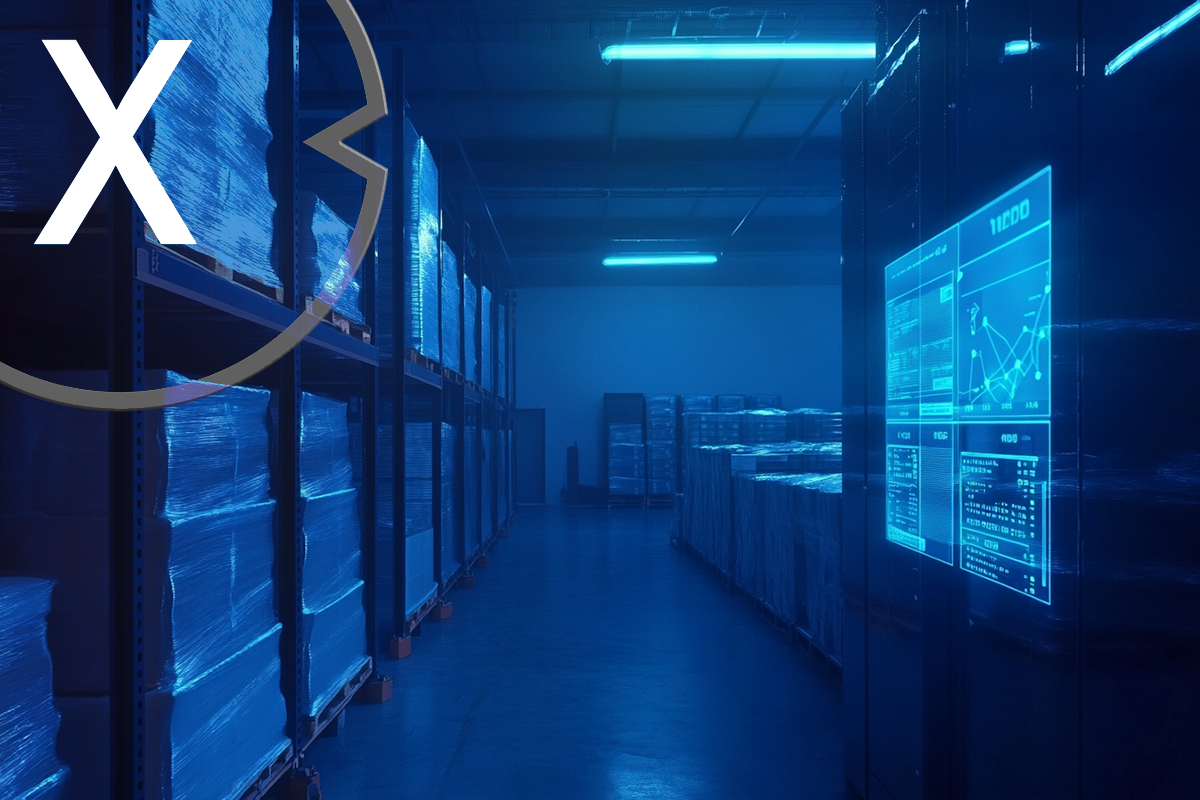
Optimizing the cold chain through the collaboration of IoT sensors and blockchain technology – Image: Xpert.Digital
🌐🔗 The combination of IoT sensors and blockchain technology
📦🛡️ The combination of IoT sensors and blockchain technology offers enormous potential to significantly improve efficiency and transparency in the cold chain. Especially in industries such as the food, pharmaceutical and logistics sectors, where temperature control and traceability are essential, this technological symbiosis enables precise monitoring and documentation of the entire cooling process. Below we'll explain how IoT sensors and blockchain work together to optimize the cold chain, the benefits they bring, and the challenges this integration can bring.
🌡️🌐 IoT sensors: The basis for real-time data in the cold chain
The Internet of Things (IoT) has found its way into cold chain logistics in recent years and enables continuous monitoring of critical environmental parameters such as temperature, humidity and pressure through the use of sensors. IoT sensors are installed in refrigerated containers, storage rooms and trucks and provide real-time data about the climatic conditions of the goods being transported or stored. These sensors can detect the smallest fluctuations and transmit data to a central system at regular intervals.
Real-time monitoring brings several advantages: Firstly, potential problems such as sudden temperature increases can be identified immediately and measures can be taken before damage to the goods occurs. On the other hand, data collection enables the creation of historical data sets that are helpful in analyzing and optimizing the cold chain. This data forms the basis for accurate and reliable reports that guarantee the quality and safety of the products.
🛡️📊 Blockchain: Security and transparency in data transmission
Blockchain technology is known for its decentralized and tamper-proof data architecture, making it ideal for cold chain data storage and sharing. While traditional databases can be vulnerable to manipulation and security vulnerabilities, blockchain offers the ability to store data securely and immutably in the form of blocks. In the cold chain, the blockchain ensures that all data collected by the IoT sensors is stored in a decentralized network and is accessible to all authorized parties. This creates an unchangeable and transparent basis for cold chain verification.
Every participant in the blockchain – be it suppliers, transport service providers or end customers – can access the data and check its integrity. This transparency makes it possible to precisely understand and document any disruptions or deviations in the cold chain. Blockchain ensures that information remains unadulterated and available without central control, increasing trust across the entire supply chain.
🔗❄️ Synergies of IoT and Blockchain in the cold chain
The combination of IoT sensors and blockchain technology offers an innovative solution for many of the typical challenges in the cold chain. The real -time data of the sensors provide precise information about the condition of the goods, while the blockchain saves this data safely and makes all legitimate parties accessible. This creates a “single source of truth” that is understandable for all actors in the supply chain.
An example of this is the transport of perishable goods such as fresh food or vaccines. IoT sensors in the shipping containers continuously record temperature and humidity, and this data is uploaded to the blockchain at regular intervals. Should a temperature deviation occur, this information is recorded immediately and everyone involved can take action to minimize the damage. This means that the quality of the goods can be guaranteed throughout the entire transport route.
➕🏷️ Advantages for cold chain logistics
1. Transparency and traceability
The blockchain enables all players to seamlessly track the entire history of a product in the cold chain. This creates trust among end customers as they can be sure that the products have been transported and stored under optimal conditions.
2. Automated alerting
By integrating IoT sensors, the system can be programmed to automatically sound an alarm if there are deviations from specified temperature values. This allows for a proactive response to potential issues before they escalate.
3. Increased efficiency
Continuous monitoring and analysis of data can help identify and optimize inefficient processes in the cold chain. In the long term, this leads to cost savings and improved resource utilization.
4. Reducing losses
Reducing losses is an important factor, especially for sensitive goods such as food and medicine. Early detection of temperature deviations and other disruptions can minimize damage and reduce losses.
5. Strengthen consumer loyalty
Transparent cold chains can be a unique selling point for companies and increase consumer trust. By completely documenting the entire cold chain, customers can be sure that the products reach the end consumer safely and in high quality.
⚙️📝 Technical challenges and solutions
Implementing IoT and blockchain in the cold chain comes with technical challenges. One of the biggest hurdles is network stability in remote areas where the transmission of sensor data can be affected. Mobile or satellite-based networks could offer a solution here to ensure continuous data transmission even in remote regions.
Another challenge is the scalability of the blockchain. With a large number of sensors continuously sending data, the blockchain architecture can quickly reach its capacity limits. Hybrid solutions could provide a solution here, in which only relevant data is included in the blockchain, while less critical information is stored in a parallel database.
The security of the IoT devices themselves is also an important aspect. Since the sensors can be vulnerable to cyber attacks, a high level of security must be guaranteed. Regular software updates and the implementation of encryption technologies can help here.
🌍🔮 How IoT and Blockchain will revolutionize the cold chain
The development of technologies is constantly advancing and the integration of IoT and blockchain is expected to continue to increase in the coming years. It is conceivable, for example, to use artificial intelligence (AI) to analyze sensor data in real time and provide proactive recommendations for action. Using machine learning, the system could detect anomalies in the data and suggest predictive measures to ensure the cold chain.
The use of smart contracts on the blockchain could also optimize the cold chain. Smart contracts are self-executing contracts that are automatically executed when certain conditions are met. For example, in the cold chain, smart contracts could ensure that an alert is automatically sent to the next partner in the supply chain when a temperature deviation is detected. This minimizes the response time and ensures the quality of the products.
🚀🔏 IoT sensors and blockchain offers a promising solution
The combination of IoT sensors and blockchain offers a promising solution to cold chain challenges. The precise capture and secure storage of real-time data can ensure the quality and safety of the transported products. The increased transparency and traceability create trust and open up new opportunities for optimizing logistics processes. Despite existing challenges, there are already promising approaches to further advance this integration and raise the efficiency and sustainability of cold chain logistics to a new level.
📣 Similar topics
- 🌐 IoT and Blockchain: The future of cold chain technology
- ❄️ Refrigerated logistics 4.0: IoT sensors meet blockchain
- 🔄 Innovations in the cold chain: Networked technologies in use
- 📈 Increased efficiency through IoT and blockchain in the cold chain
- 🔗 Blockchain as a protective shield for the sensitive data of the cold chain
- 🚚 Real-time monitoring in cold chain logistics
- 🧊 Synergies of IoT and Blockchain for cold chain dependent industries
- 💼 Challenges in integrating modern technologies into the cold chain
- 🚀 Future prospects: The next stage of the cold chain revolution
- 👥 Consumer loyalty through transparent cold chain solutions
#️⃣ Hashtags: #IoT #Blockchain #Cold Chain #Realtime Data #Transparency
Xpert partner in warehouse planning and construction
🌿❄️ Blockchain for the green cold chain: innovative leap in fresh produce logistics 🚚📦
Several companies have already implemented successful blockchain cold chain solutions to improve transparency, traceability and efficiency in the logistics of temperature-sensitive goods. Here are some prominent examples:
1. IBM and Maersk
IBM and Maersk have developed a blockchain solution specifically used for the cold chain in food and pharmaceutical logistics. This solution improves the visibility and efficiency of tracking assets along the supply chain by storing immutable temperature data to ensure compliance.
2. SkyCell
SkyCell has developed smart refrigerated containers equipped with IoT sensors that are used to transport medicines. These containers monitor location, temperature and humidity conditions in real time. The data is stored in a blockchain to ensure tamper-proof documentation.
3. Walmart
Walmart has been using blockchain technology since 2018 to improve food traceability in its supply chain. An example is tracking leafy vegetables, where blockchain makes it possible to identify the origin of a product within seconds. Not only does this help with recalls, but it also improves food safety.
4. Overhaul
Overhaul introduced a cold chain quality management solution based on blockchain technology in 2024. This solution aims to manage risk and quality for temperature-sensitive goods in industries such as pharmaceuticals and food.
5. Coforge
Coforge offers a blockchain-based cold chain solution specifically aimed at the transportation of organic products and pharmaceutical goods. This solution uses IoT sensors to monitor temperature and humidity conditions in real time during transportation.
Blockchain technology in cold chain logistics
These companies demonstrate how blockchain technology is successfully used in cold chain logistics to provide transparency, prevent fraud, and minimize losses due to improper storage or transportation.
Xpert.Plus warehouse optimization - high-bay warehouses such as pallet warehouses consulting and planning
We are there for you - advice - planning - implementation - project management
☑️ SME support in strategy, consulting, planning and implementation
☑️ Creation or realignment of the digital strategy and digitalization
☑️ Expansion and optimization of international sales processes
☑️ Global & Digital B2B trading platforms
☑️ Pioneer Business Development
I would be happy to serve as your personal advisor.
You can contact me by filling out the contact form below or simply call me on +49 89 89 674 804 (Munich) .
I'm looking forward to our joint project.
Xpert.Digital - Konrad Wolfenstein
Xpert.Digital is a hub for industry with a focus on digitalization, mechanical engineering, logistics/intralogistics and photovoltaics.
With our 360° business development solution, we support well-known companies from new business to after sales.
Market intelligence, smarketing, marketing automation, content development, PR, mail campaigns, personalized social media and lead nurturing are part of our digital tools.
You can find out more at: www.xpert.digital - www.xpert.solar - www.xpert.plus

